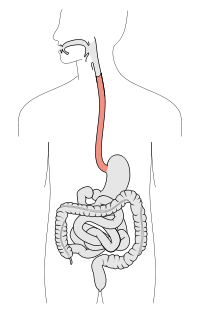
Photo from wikipedia
Many mouse models have been developed to mimic the inflammation-metaplasia-dysplasia-carcinoma sequence seen in the gastroesophageal reflux disease (GERD)-Barrett's esophagus-esophageal adenocarcinoma progression. Surgical reflux models in mice are technically challenging due… Click to show full abstract
Many mouse models have been developed to mimic the inflammation-metaplasia-dysplasia-carcinoma sequence seen in the gastroesophageal reflux disease (GERD)-Barrett's esophagus-esophageal adenocarcinoma progression. Surgical reflux models in mice are technically challenging due to the small size and intolerance to surgical stress of mice. Herein, we detail three representative surgical procedures that allow for creation of an esophageal adenocarcinoma model in mice, either with or without the use of carcinogens. Additionally, we describe a genetic model that shows spontaneous development of esophageal adenocarcinoma.
Journal Title: Methods in molecular biology
Year Published: 2018
Link to full text (if available)
Share on Social Media: Sign Up to like & get
recommendations!